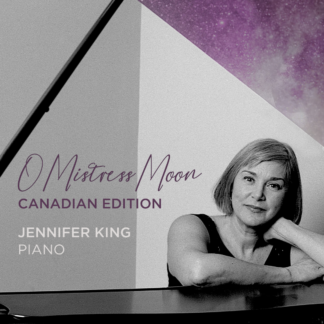Description
Partons, la mer est belle
Leaf Music and Christina Haldane present Partons, la mer est belle, the first and only single from the forthcoming album, Tu Me Voyais, set to be released through Leaf Music on October 21, 2022. Carl Philippe Gionet’s arrangement of the evocative Acadian folk song Partons, la mer est belle is reimagined from a long lineage of interpretations from folk singers dating back to the 1800s.
This traditional Acadian folk song reflects on the cyclical nature of life and the hardships of living and working on the ocean. The song stems from the aural tradition, where music and lyrics are passed down through generations without the use of notation or text, resulting in each new generation sculpting its own interpretation.
Gionet’s arrangement focuses on achieving a balance between remaining faithful to the aural renditions he received in childhood and allowing Haldane’s tenor and inflection to drape a new interpretation over the music. Gionet’s arrangement is inspired by the 19th century Lieder style, in which the voice and piano share solo responsibilities and the spotlight equally. New harmonic colours provide depth to the musical landscape and expand the sonic palette of the piece. Certain liberties have been taken with the traditional text, including adding reprises to enhance the dramatic arc of the storytelling.
Leaf Music et Christina Haldane vous présentent Partons, la mer est belle, premier et unique extrait de l’album Tu me voyais, dont la parution chez Leaf Music est prévue le 21 octobre 2022. L’arrangement créé par Carl Philippe Gionet de la chanson folklorique acadienne évocatrice intitulée « Partons, la mer est belle » est le fruit de l’imagination d’un artiste inspiré par la longue lignée des interprétations de cette chanson par des chanteurs folkloriques depuis le dix-neuvième siècle. Cette chanson folklorique de la tradition acadienne évoque la nature cyclique de la vie et les épreuves de la vie et du travail en mer. Il s’agit d’une chanson qui relève de la tradition orale, avec une musique et des paroles qui ont été transmises d’une génération à l’autre sans recours à l’écrit ni à la notation musicale, de sorte que chaque nouvelle génération en a produit sa propre interprétation.
L’arrangement de C. P. Gionet cherche à ménager un équilibre entre la fidélité aux versions qu’il a entendues dans son enfance et le souci de permettre à la substance et aux inflexions de la voix de Christina Haldane d’envelopper la musique dans une nouvelle interprétation. Cet arrangement s’inscrit dans la lignée des Lieder du dix-neuvième siècle, genre musical dans lequel la voix et le piano interprètent tous deux des parties solos sur un pied d’égalité. Ses nouvelles harmonies donnent au paysage musical une plus grande profondeur et élargissent la palette sonore du morceau. L’arrangeur a pris certaines libertés vis-à-vis du texte traditionnel, avec l’ajout de répétitions quand cela était nécessaire pour donner une plus grande ampleur dramatique aux pièces.













